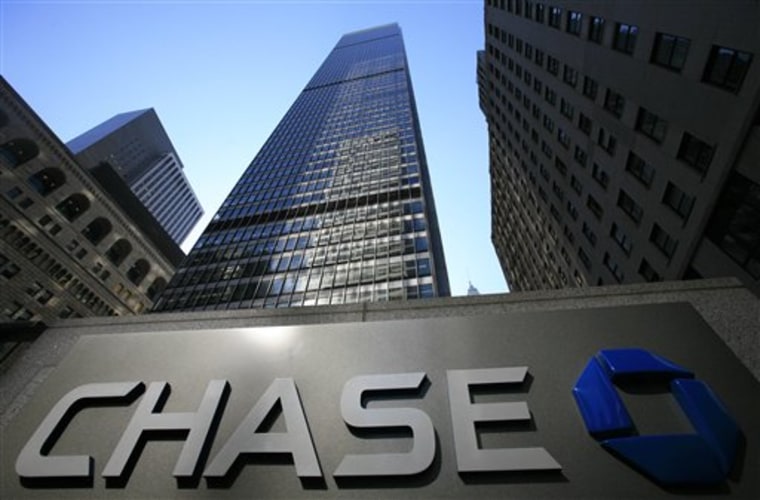The long national banking nightmare may be over — but only for a select few banks.
On Thursday, JPMorgan Chase & Co., bolstered by strength in investment banking, reported a 36 percent increase in second quarter profit that beat analysts' expectations.
The report follows news from Goldman Sachs on Tuesday of a stunning $2.7 billion profit less than a year after one of the worst financial crises since the Great Depression began. Revenues soared 39 percent to $25.62 billion.
But most of the industry remains mired in a pile of bad debts and rising defaults that continue to weigh on profits and balance sheets. CIT, struggling for survival under the pressure of continuing loan losses, was denied a federal lifeline Wednesday and now faces the prospect of bankruptcy or possible liquidation.
"The financial crisis is not over,” Stephen Roach, chairman at Morgan Stanley Asia said on CNBC. “The (International Monetary Fund) is telling us that by the end of this crisis $4 trillion worth of bad assets will be written down. Thus far financial institutions have written off, at most, half of that. So there plenty more to come.”
The surprisingly strong results at Goldman Sachs Tuesday sparked a wave of optimism that the heavy losses that have battered the banking industry for over a year may finally be easing. But a closer look at where Goldman made those profits may temper that enthusiasm. Profits were driven by record investment banking fees, including the underwriting of new stock sales for companies trying to raise cash.
With traditional investment banking competitors like Lehman Bros. and Bear Stearns no longer around to compete for investment banking business, Goldman Sachs was able to substantially increase its share of that business.
“Goldman is essentially the last investment house standing,” said Matt McCormick, a banking analyst at Bahl and Gaynor Investment Counsel. “So they have the ability not only to attract and retain great employees, but they have the ability to attract and retain great clients."
JPMorgan also saw big gains in its investment banking business and in revenues from bond trading, profit centers that only a handful of other large banks enjoy.
On Friday, Bank of America reported better-than-expected second-quarter earnings of $2.42 billion, but also said it was plagued by losses from failed loans. Citigroup posted a profit of $3 billion, instead of the loss Wall Street expected, but its earnings were helped by a gain of $6.7 billion from selling its stake in Smith Barney. Rising costs for bad loans also nagged Citigroup.
“When I look at the rest of the banks, I don't like what I see," said Jim LaCamp, a portfolio manager with Macroportfolio Advisors. "We still have deteriorating credit quality on real estate loans, commercial real estate loans on credit cards and so the regional banks are all still reeling."
Smaller banks, or those deemed “not too big to fail” are also struggling to right themselves. So far this year the FDIC has taken over failed banks at the rate of about two a week. The FDIC’s list of “troubled banks” stood at 305 at the end of the first quarter, the latest data available.
The outlook is especially cloudy because of uncertainty about the timing and strength of the economic recovery. In its earnings report Thursday, JPMorgan CEO Jamie Dimon cautioned that it’s not clear whether the economy will deteriorate further in the second half of the year.
“We expect unemployment to get worse," he said in a statement.
The bank said delinquent home equity loans “have started to stabilize." But a separate report Thursday said the number of households on the verge of losing their homes soared by nearly 15 percent in the first half of the year as rising job losses kept more homeowners from paying their monthly mortgage bills.
The data from foreclosure listing service RealtyTrac showed that, despite the Obama administration's $50 billion subsidies efforts to spur lenders to modify mortgages to more affordable terms, the nation's housing woes are spreading. Foreclosures are not expected to peak until the middle of next year. Until foreclosures can be contained, distressed sales will continue to weigh on housing prices and erode the value of loans and mortgage-backed securities on banks’ books.
Analysts say the commercial real estate market is also suffering as businesses hit hard by the recession have closed up shop, canceled leases and defaulted on commercial mortgages.
“Eventually, a lot of these mortgage-backed securities may wind up providing some gains, but I think that's a long way off,” said Jeffery Harte, a banking analyst at Sandler O'Neill. “We have to see how bad the credit headwinds are near term and at what point in time does both consumer and CEO confidence grow enough to say it's going to be OK, let's start thinking about growth as opposed to just the curtailing things."
Banks are also struggling with a mountain of bad credit card and other consumer debt, which will remain under pressure until the economy begins to stage a solid recovery and the job market stabilizes. Despite isolated data showing improvement, most economists expect the economic recovery to be weak. Without solid gains in wages, consumers will likely remain hunkered down and continue to curtail spending.
“Seventy-five percent of the world’s economies today are still contracting,” said Roach. “And the biggest piece of on the demand side of the global economy is the American consumer who is dead in the water. So this is going to be an unusually anemic recovery.”
